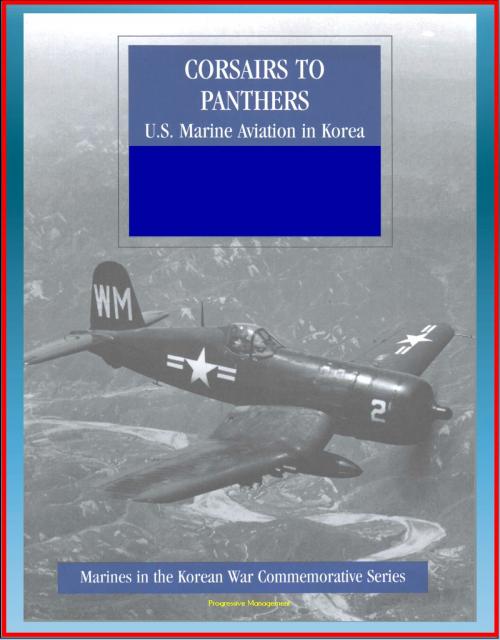Marines in the Korean War Commemorative Series: Corsairs to Panthers - U.S. Marine Aviation in Korea - Tigercat, F4, Night-Fighter Squadrons, 1st Marine Aircraft, Bell and Sikorsky Helicopters
Nonfiction, History, Asian, Korean War, Military, Aviation| Author: | Progressive Management | ISBN: | 9781301884636 |
| Publisher: | Progressive Management | Publication: | January 5, 2013 |
| Imprint: | Smashwords Edition | Language: | English |
| Author: | Progressive Management |
| ISBN: | 9781301884636 |
| Publisher: | Progressive Management |
| Publication: | January 5, 2013 |
| Imprint: | Smashwords Edition |
| Language: | English |
This exceptional USMC history provides unique information about U.S. Marine aviation in the Korean War, with information about the Vought F4U Corsair, Grumman F7F Tigercat, Douglas F30 Skynight, Marine night-fighter squadrons, 1st Marine Aircraft Wing Leaders, Marine Observation Squadron, Bell and Sikorsky helicopters, major-league baseball player reservists including Ted Williams, and night MIG killers, the flying nightmares.
The first major surprise of the post-World War II years came into play when in late June 1950, the United States found itself responding in crisis fashion to the North Korean invasion of the new republic of South Korea, just four years and nine months after VJ-Day. The nation became involved in Korea as a result of the Cairo and Yalta conferences in which the United States and the Soviet Union agreed to the concept of a free and independent post-war Korea. Included in the agreement was a joint occupation of the country by the two powers, with the Soviets north of the 38th Parallel and the United States south. The concept of the occupation had a general objective of settling down Korea for a period so that it could learn to govern itself as a nation after many decades of Japanese rule. As the United States was painfully learning, however, it soon became apparent that what the Soviets said was one thing and what they intended was quite another with respect to a free, independent, and democratic Korea. When in 1948, they refused to participate in elections, supervised by the United Nations to form the first National Assembly, the hopes for a united Korea died. The Soviets formed a separate Communist state in their sector, the People's Democratic Republic of Korea. With the elections completed for the National Assembly in the south, the Republic of Korea (ROK) was established and the United States trusteeship in the country came to an end.
On 25 June 1950, the North Koreans attacked with nine well-equipped infantry divisions, spearheaded by one armored division equipped with Soviet-built T-34 tanks. The Republic of Korea's army had been in existence for just about a year and could only oppose the invasion with four lightly equipped divisions and one additional regiment. Needless to say, although there were some spirited but isolated small unit defensive actions, the Republic's forces were no match for the invaders. The North Koreans reached out with rapidly advancing armored columns, moving almost at will during the first four days. Seoul fell on 28 June, and at that time, the ROK army had 34,000 troops missing, although many of them later returned to their units. With the capture of Seoul, the invaders halted to regroup and those ROK forces, which were still intact, fell back through Suwon to set up some form of new defensive positions. The South Korean government had displaced to Taejon well to the south when the fall of Seoul became imminent. This state of near collapse was the basic situation faced by the United States and the United Nations in the opening week of the war. It was the first time that a Soviet-supported state was permitted to go as far as open warfare in their post-World War II depredations, and it constituted a definite showdown between the Communist and non-Communist worlds.
The United States responded to the invasion of South Korea both independently, and through strong support and leadership in a United Nations resolution condemning the breaking of world peace by the North Koreans. President Harry S. Truman gave General of the Army Douglas MacArthur, Commander in Chief, Far East, the go-ahead to send Army units into Korea from Japan and to take other actions in support of the shocked and shattered ROK forces. It is important to note that of the 56 respondents to the United Nations resolution, only three were opposed: the Soviet Union, Poland, and Czechoslovakia.
This exceptional USMC history provides unique information about U.S. Marine aviation in the Korean War, with information about the Vought F4U Corsair, Grumman F7F Tigercat, Douglas F30 Skynight, Marine night-fighter squadrons, 1st Marine Aircraft Wing Leaders, Marine Observation Squadron, Bell and Sikorsky helicopters, major-league baseball player reservists including Ted Williams, and night MIG killers, the flying nightmares.
The first major surprise of the post-World War II years came into play when in late June 1950, the United States found itself responding in crisis fashion to the North Korean invasion of the new republic of South Korea, just four years and nine months after VJ-Day. The nation became involved in Korea as a result of the Cairo and Yalta conferences in which the United States and the Soviet Union agreed to the concept of a free and independent post-war Korea. Included in the agreement was a joint occupation of the country by the two powers, with the Soviets north of the 38th Parallel and the United States south. The concept of the occupation had a general objective of settling down Korea for a period so that it could learn to govern itself as a nation after many decades of Japanese rule. As the United States was painfully learning, however, it soon became apparent that what the Soviets said was one thing and what they intended was quite another with respect to a free, independent, and democratic Korea. When in 1948, they refused to participate in elections, supervised by the United Nations to form the first National Assembly, the hopes for a united Korea died. The Soviets formed a separate Communist state in their sector, the People's Democratic Republic of Korea. With the elections completed for the National Assembly in the south, the Republic of Korea (ROK) was established and the United States trusteeship in the country came to an end.
On 25 June 1950, the North Koreans attacked with nine well-equipped infantry divisions, spearheaded by one armored division equipped with Soviet-built T-34 tanks. The Republic of Korea's army had been in existence for just about a year and could only oppose the invasion with four lightly equipped divisions and one additional regiment. Needless to say, although there were some spirited but isolated small unit defensive actions, the Republic's forces were no match for the invaders. The North Koreans reached out with rapidly advancing armored columns, moving almost at will during the first four days. Seoul fell on 28 June, and at that time, the ROK army had 34,000 troops missing, although many of them later returned to their units. With the capture of Seoul, the invaders halted to regroup and those ROK forces, which were still intact, fell back through Suwon to set up some form of new defensive positions. The South Korean government had displaced to Taejon well to the south when the fall of Seoul became imminent. This state of near collapse was the basic situation faced by the United States and the United Nations in the opening week of the war. It was the first time that a Soviet-supported state was permitted to go as far as open warfare in their post-World War II depredations, and it constituted a definite showdown between the Communist and non-Communist worlds.
The United States responded to the invasion of South Korea both independently, and through strong support and leadership in a United Nations resolution condemning the breaking of world peace by the North Koreans. President Harry S. Truman gave General of the Army Douglas MacArthur, Commander in Chief, Far East, the go-ahead to send Army units into Korea from Japan and to take other actions in support of the shocked and shattered ROK forces. It is important to note that of the 56 respondents to the United Nations resolution, only three were opposed: the Soviet Union, Poland, and Czechoslovakia.















